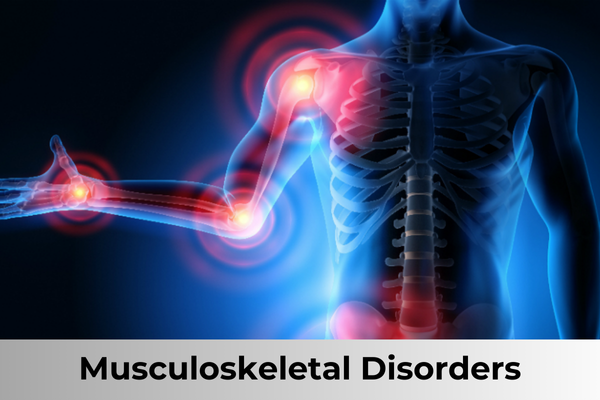Understanding Musculoskeletal Disorders: Causes, Symptoms, and Management
Musculoskeletal disorders (MSDs) affect millions worldwide, impacting bones, muscles, tendons, ligaments, and nerves. These disorders can range from acute injuries to chronic conditions, significantly affecting quality of life. This article explores common musculoskeletal disorders, their causes, symptoms, and management strategies to help you stay informed and proactive about your musculoskeletal health.
What Are Musculoskeletal Disorders?
Musculoskeletal disorders encompass a variety of conditions affecting the musculoskeletal system, including bones, muscles, tendons, and ligaments. They can be acute, like fractures or sprains, or chronic, such as arthritis or osteoporosis.
Key Points:
- Acute Disorders: Sudden injuries such as fractures and sprains.
- Chronic Disorders: Long-term conditions like osteoarthritis and rheumatoid arthritis.
Common Musculoskeletal Disorders
1. Osteoarthritis (OA)
Osteoarthritis is the most prevalent form of arthritis, leading to the gradual breakdown of joint cartilage. It commonly affects weight-bearing joints such as the knees, hips, and spine.
- Causes: Aging, joint injuries, and genetic factors.
- Symptoms: Joint pain, stiffness, reduced range of motion, and swelling.
2. Rheumatoid Arthritis (RA)
Rheumatoid arthritis is an autoimmune condition that causes chronic inflammation in the joints, often starting in the smaller joints of the fingers and toes.
- Causes: Autoimmune response and genetic factors.
- Symptoms: Morning stiffness, symmetrical joint pain, fatigue, and fever.
3. Osteoporosis
Osteoporosis is characterized by weakened bones, increasing the risk of fractures. It often develops without symptoms until a fracture occurs.
- Causes: Age, hormonal changes, and nutritional deficiencies.
- Symptoms: Frequent fractures, loss of height, and stooped posture.
4. Back Pain
Back pain is a widespread issue, ranging from acute to chronic. Causes can include poor posture, a sedentary lifestyle, or muscle strain.
- Causes: Poor posture, sedentary habits, and heavy lifting.
- Symptoms: Sharp or dull pain, stiffness, and pain radiating down the legs (sciatica).
5. Tendinitis
Tendinitis is the inflammation of a tendon, usually caused by repetitive strain or direct trauma. It commonly affects the shoulders, elbows, and knees.
- Causes: Repetitive motion, aging, and trauma.
- Symptoms: Pain and tenderness around the affected tendon, swelling, and reduced range of motion.
Diagnosing Musculoskeletal Disorders
Effective diagnosis of musculoskeletal disorders involves:
- Physical Examination: Assessing pain, range of motion, and functional impairment.
- Imaging Studies: X-rays, MRIs, and CT scans to identify structural changes.
- Laboratory Tests: Blood tests to diagnose autoimmune or infectious conditions.
Managing Musculoskeletal Disorders
1. Medications
- Pain Relievers: Over-the-counter drugs like acetaminophen and NSAIDs for pain and inflammation.
- Disease-Modifying Drugs: For conditions like RA, to slow disease progression.
- Bone-Strengthening Medications: Bisphosphonates for osteoporosis.
2. Physical Therapy
- Exercise Programs: Improve strength, flexibility, and mobility.
- Manual Therapy: Techniques such as massage and joint manipulation.
- Education: Guidance on posture, body mechanics, and ergonomic adjustments.
3. Lifestyle Modifications
- Weight Management: Reducing stress on joints through a healthy weight.
- Nutrition: Eating a balanced diet rich in calcium and vitamin D.
- Regular Exercise: Engaging in low-impact activities to strengthen muscles.
4. Surgical Interventions
- Joint Replacement: For severe osteoarthritis or joint damage.
- Arthroscopy: Minimally invasive surgery for diagnosing and treating joint problems.
Preventing Musculoskeletal Disorders
Preventive measures include:
- Regular Exercise: Engaging in physical activity to strengthen muscles and support joint health.
- Proper Body Mechanics: Using correct techniques for lifting and repetitive tasks.
- Healthy Diet: Ensuring adequate intake of nutrients essential for bone and joint health.
Conclusion
Musculoskeletal disorders encompass a range of conditions that can impact daily life and overall well-being. By understanding these disorders, their causes, symptoms, and management strategies, you can take proactive steps to maintain musculoskeletal health and improve your quality of life. For persistent or severe symptoms, consult a healthcare professional for accurate diagnosis and tailored treatment. for more information Visit Our website wellbeingprotips.

